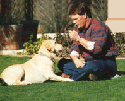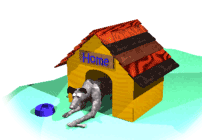|
|
|
|
 |
||||||
|
Aversive Control and Clicker Training NOTE: If you have chosen this page as the place to start in your clicker training education, you are in the wrong spot. Please go to my first F&F article and start there. This article requires a context in order to understand this very important topic. -- Gary Wilkes Clicker training is "all positive". Lose weight without exercise or dieting. Our phone psychics are "certified". Painless Dentistry. The check is in the mail. I never, ever, had sex with that woman, Miss Lewinski. ” Now that we have set the tone for this column, let me say this as clearly as possible. Clicker Training for dogs started in 1987 - five years before Karen Pryor and I gave the first clicker training seminar, in Northern California. Between '87 and '92 I clicker-trained over 1,000 clients and their dogs. Throughout that period, clickers were an integral part of my training program - and so was aversive control. That's a fact. It is also a fact that because clicker training is so incredibly efficient, aversive control is a tiny but crucial part of any successful training method. So, the concept that clicker training is "all positive" is a matter of personal choice rather than science or tradition. The real issue isn't whether you use some form of "negatives", the issue is whether your training techniques A) benefit your dog and B) cause no harm. (Coincidentally, those are the same ethics that separate a butcher from a surgeon.) Suggesting that training (mental health) should never include any form of discomfort is as impractical as requiring the same of a veterinarian or any other doctor. So, it is my long-standing belief that there is a time and a place to say "NO!" Whether you use clicker training or some other method, there will come a day when you dog looks at you and says, "I don't think I'll do that." While this "willful disobedience" is often denied by "experts", it is a pretty common occurrence in the real world of dog training. For that matter, if you deny "willful disobedience" you must also deny possibility of "willful cooperation." This mechanistic view of dogs is not supported by objective observation. No matter how much one wants to pretend, dogs possess behaviors that are not automatically eliminated merely because we have a great way of teaching them new behaviors. When your dog is off-leash in a park and decides to chase a squirrel, it is too late to connect the word "No!" to an actual unpleasant consequence. If you are trusting "all positive" training to inhibit a dog's natural predatory behavior, you are likely to be disappointed, and your dog may be in jeopardy. That means that you must teach this association before you actually need to use it. So, two last reminders and we'll get started 1) If you have a problem with the use of harmless punishment, don't use it. 2) If you have a problem with making sure you "do no harm", don't use punishment as a training tool. The General Concept of Aversion: To get started using punishment, you have to discover something your dog really doesn't like that doesn't cause any harm. Dogs are highly variable on this point - some will fall apart if you look at them askance, while others are not bothered by the most powerful leash corrections. As a general rule, I don't use anything as a punisher that could injure the dog, even if something goes wrong. That rules out throw cans, throw chains and throw "keys" - I don't throw anything at a dog that might do damage if it accidentally lands in the dogs face. I also avoid loud noises as punishers. In my part of the world, Arizona, we have two seasons of thunderstorms and lightning each year. Using loud noises as punishment can increase the likelihood that the dog will fear loud noises. The two punishers I use are a squirt of water and a soft object, thrown with the intention of hitting the dog. On first inspection, throwing something at a dog will tend to draw speculative criticism. However, the proof is in the pudding. A throw pillow or rolled up towel used as a projectile is a safe and effective way to apply punishment. Those who imagine that this will cause hand-shyness, fear of the owner or fear of flying objects are speaking from ineptitude or ignorance - or both. Before you go running off to bonk or spritz your dog for breaking a stay, hold your horses - we aren't quite ready yet. It shouldn't surprise you that using a conditioned punisher followed by an actual punisher is many times for accurate than just zapping the dog. This is complimentary and symmetrical to the use of the clicker. Creating and correctly using a conditioned punisher can dramatically increase the effectiveness of the punishment - and thereby reduce the amount you must use. Creating a Conditioned Punisher: For several thousand years, people have been saying "NO!" to tell a dog what not to do. Most of the time, the words are wasted and the dog continues to do the wrong thing. The primary reason for this lack of response is that it is not natural for a human to bark out the word "NO" BEFORE the actual punishment is applied. However, unless the word "NO" comes first, the dog will have trouble making the required association between the signal and the punishment. Once this association is made, the conditioned punisher acts like a negative clicker, to identify which behaviors should be avoided. Before you pass over the last paragraph, I want to reiterate something. Almost 95% of people who attempt this process initially screw it up. That's because they say "NO" at the same instant they start moving to apply the actual punishment - or worse, they start moving BEFORE they say "NO!". If this happens, the dog will simply pay attention to movement and will never really learn the meaning of "NO!" So, when you say "NO!", repeat your full name, inside your head, before you move a muscle. In some applications, you may have to reduce this time-gap, but the main point is that the word must come first. Don't threaten: Another critical mistake is to threaten the dog with the spray bottle or bonker. If you make the sight of the punisher the most important part of the process, the dog will only obey when they see the towel or sprayer. Rarely Bluff: It is common for people to stop using the actual punishment and only use the word "NO!". This is often justified by saying "The dog stopped the behavior as soon as I said NO!" That's not the point. The issue is not wether the word "No!" can make your dog stop for a second, the issue is stopping the behavior for the future. If you bluff consistently, you are encouraging the dog to try to beat the system. If you set aside the time to use punishment correctly, it shouldn't take more than three or four attempts. If you bluff, this number can double or triple. If It Doesn't Work: No person is capable of knowing everything about behavior. If you apply punishment and it doesn't stop the behavior within three or four attempts - stop using it, there is something wrong. This is the time to reexamine your methods and whether your decision to use punishment was correct. Continuing to apply punishment without any noticeable change in the dog's behavior isn't training, it's abuse. Last, but not least: As often as I say this, I am still amazed at the number of people who skip the most important part of using punishment - you aren't done until the dog's tail is wagging again. Every time I start a program that includes some form of punishment, I make sure that I don't finish until the dog is happy with the new rules. PERIOD! If you use the information in this article and don't follow through to the end, you are either a jerk or a particularly low form of idiot. Your moral obligation in using punishment is to make sure your dog benefits from the experience. Failing to finish up with positive reinforcement is like a surgeon who performs a life saving, invasive operation and then fails to close the wound. Real Life Example: A few weeks ago, I gave a class to the trainers of a hearing and service-dog organization. One of the dogs was quite unbridled, easily distracted and never quite stopped moving. She was a year old Lab mix - enough said. The dog's ability to work as a service dog depended on controlling her wildness. The options of using positive reinforcement for alternative behaviors simply hadn't worked. So, as her handler brought her toward me, I waited for the dog to bunch her muscles to jump on me. At the instant I saw her tense, I said "NO" in a slightly emphasized tone of voice. As she bolted up toward my face, I brought a bonker down from my shoulder that hit her right on top of the head. She was startled and backed off for a second. I asked the handler to move her away for a few seconds. End of "round one." Next, I asked the handler to bring her up again. She bunched her muscles and I said "NO", just as I did the first time. Her upward surge was far less forceful on the second repetition, and the bonk caught her before she could really fully extend. End of "round two." On round three, she didn't jump - she sat. I baby-talked her and patted my chest, inviting her to jump up - she just sat there. Click and treat. We ran a few more repetitions with only clicks and treat - she simply wasn't going to jump. Rather than transferring this to another person, I decided to use this new set of rules for another behavior - "Down/Stay". Go to the next article | Go to Prior Article | Go to the First article |
||||||
|
Copyright 1991-2006 Gary Wilkes - All rights reserved. No portion of this website may be reproduced without permission. For questions regarding reprinting articles and copyright, contact Gary Wilkes at wilkesgm@aol.com |
||||||
|
Copyright 1991-2006 Gary Wilkes - All rights reserved. No portion of this website may be reproduced without permission. For questions regarding reprinting articles and copyright, contact Gary Wilkes at wilkesgm@aol.com |
||||||



